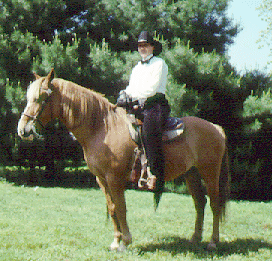Cayuse Indian Pony
 Cattle drives, shootouts and the U.S. Cavalry all added excitement to the Old West.
It was the wild horse, however, that became a symbol of everything the West stood
for – freedom, stamina and the ability to survive hardship.
Cattle drives, shootouts and the U.S. Cavalry all added excitement to the Old West.
It was the wild horse, however, that became a symbol of everything the West stood
for – freedom, stamina and the ability to survive hardship.
One little known horse from that period of American history is the famed Cayuse Indian Pony of the Northwest. Although the settlers called most horses raised by the American Indians "cayuse ponies", the Cayuse Indian Pony of the Northwest is a distinct breed which originated in the 1800's. Its conformation and its background set it apart from the Mustang, Spanish Barb or other wild horses.
Small and stocky, the Cayuse Indian Pony has high withers and an unusually long canon bone. In addition, its distinctly sloped pastern gives it a broken walking gait. Any rider, especially younger children, will find this an extremely pleasant and easy seat.
Frederic Remington, who is famous for his artistic representations of the Old West, sketched many of the wild horses he found in the late 1800s. He described the Cayuse Indian Pony as "generally roan in color, with always a tendency this way, no matter how slight." Remington wrote that his subject was heavily muscled, and while only about fourteen hands high, was still very powerful.
The breed's history is obscure and difficult to trace. It has been generally accepted that the Cayuse Indian Pony descended from the French-Norman horses imported into Canada in the 1600s. Most of these French horses were Percherons, which the Canadians used to improve their domestic breeds. The Percheron was a good choice -- it continues to be one of the only work horses which can easily trot for extended periods of time.
Years later, the French Canadians brought their horses into what is now American territory. It was recorded that they bartered their horses in St. Louis with the Pawnee Indians, who then took them further west. Eventually, the Indians crossed their sturdy French horses with the lighter Spanish Barbs to produce a horse which had not only speed, but endurance.
By the 1800s, the Cayuse Indian Pony had become a separate breed. The Cayuse Indians, known throughout the Northwest for their expert horsemanship, continued to develop this French-Spanish Barb strain through selective breeding. Because the French horse had the ability to pass on its tendency for spots or a profusion of white markings, the Cayuse Indians were able to produce some very colorful horses. In fact, the Appaloosa, Paint and Pinto breeds have all been influenced by the blood of the Cayuse Indian Pony.
Today, the breed is seldom seen outside California. Only a handful are even still in existence. Jeff Edwards, co-founder of the Wild Horse Research Center in Porterville, California has gradually been trying to rebuild a herd and protect it from extinction. Over 100 head of Cayuse Indian Ponies were lost several years ago when their pasture land was sprayed with a toxic herbicide.
But the Wild Horse Research Center is optimistic about the breed's recovery. Recently, they donated a Cayuse Indian Pony to the Kentucky Horse Park near Lexington with the hope that more people could discover the saga if this unique horse. They are also working with one small stud bunch at the farm and anxiously await the spring foals each year.
The Center has also established a registry for wild horses and ponies possessing barb blood. The Cayuse Indian Pony can now be officially registered as one of the "Horse of the Americas" breeds. Edwards determined the purity of each horse based on its physical characteristics and charts researched by the Wild Horse Research Center.
For additional information contact Jeff Edwards, Wild Horse Research Center, 248 N. Main Street, Porterville, California 93257.
References
Kentucky Horse Park, 4089 Iron Works Pike, Lexington, KY 40511
